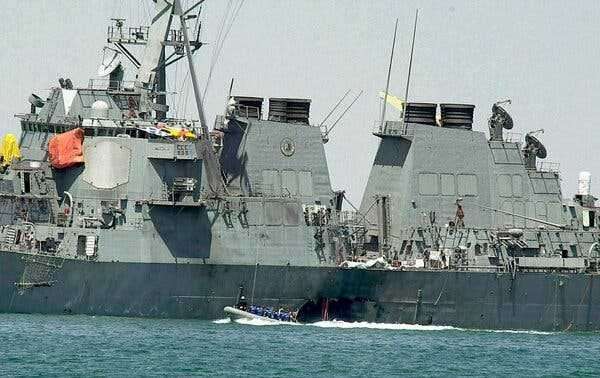What to know about the death-penalty prosecution of a Saudi prisoner accused of plotting the attack on a Navy destroyer off Yemen in 2000 that killed 17 sailors.

The U.S.S. Cole was attacked by suicide bombers during a routine refueling stop in the port of Aden, Yemen on Oct. 12, 2000.
The Crime
Saudi national Abd al-Rahim al-Nashiri is accused of organizing the Qaeda bombing of the U.S. Navy destroyer Cole on Oct. 12, 2000. Two men sailed a bomb-laden skiff alongside the Cole during a routine refueling stop in the port of Aden, Yemen, then blew themselves up. Seventeen American sailors died, and dozens more were wounded. Mr. Nashiri is also accused of a role in the 2002 bombing of the Limburg, a French-flagged, Malaysian-chartered tanker that was carrying Iranian crude oil. A Bulgarian crew member was killed in that attack.
The U.S.S. Cole bombing case is the lesser known of the two death-penalty cases being pursued at a military commission at Guantánamo Bay. The other is the case against the five men accused of plotting the attacks of Sept. 11, 2001.
The Trial
Several dates have been set aside for selection of the 12 or more U.S. military officers who would serve on the jury for the death-penalty trial. The case has been in pretrial proceedings since Mr. Nashiri’s arraignment in November 2011, in part because of higher court challenges by both the prosecution and defense lawyers to decisions by the case judges, and in part because two years of judicial rulings by an earlier judge were thrown out when he was found to have a conflict of interest. A major impediment has been the slow pace of disclosure to defense lawyers about the C.I.A. prison network, known as black sites, where the defendant was held for four years before his transfer to Guantánamo in September 2006. Hearings also were put on hiatus for more than 500 days because of the coronavirus pandemic.
The Victims
ImageAl Qaeda claimed responsibility for the attack on the Cole, which killed 17 American sailors.Credit…Thomas Kienzle/Associated Press
Seventeen sailors were killed in the attack: Kenneth E. Clodfelter, 21; Richard Costelow, 35; Lakeina M. Francis, 19; Timothy L. Gauna, 21; Cherone L. Gunn, 22; James R. McDaniels, 19; Marc I. Nieto, 24; Ronald S. Owens, 24; Labika N. Palmer, 22; Joshua L. Parlett, 19; Patrick H. Roy, 19; Kevin S. Rux, 30; Ronchester M. Santiago, 22; Timothy L. Saunders, 32; Gary G. Swenchonis Jr., 26; Andrew Triplett, 31, and Craig B. Wibberley, 19.
A liaison to the victims, who works for the prosecution, selects surviving crew members as well as family members of those who were killed in the attacks to observe the proceedings at Guantánamo Bay. Shipmates from that day and the parents of fallen sailors have become familiar faces in the gallery at the back of the court, where members of the public who gain admission to the national security court can watch the proceeding live and hear the audio on a 40-second delay. Family members and victims of the attack can also observe a video feed of the proceedings from a viewing room in Norfolk, Va., the home port of the Cole.
The Judge
ImageArmy Col. Lanny J. Acosta Jr. served as a prosecutor, legal assistance lawyer and staff attorney before becoming a judge in July 2015.Credit… Office of Military Commissions
Army Col. Lanny J. Acosta Jr., the chief of the Guantánamo Trial Judiciary, is currently serving as the pretrial judge. He earned a law degree from the University of Mississippi in 1998 and then obtained a commission in the Army. He served as a prosecutor, legal assistance lawyer and staff attorney before becoming a judge in July 2015. The initial judge in the case, Army Col. James L. Pohl, handed it off to Air Force Col. Vance H. Spath. A higher court subsequently vacated two years of Colonel Spath’s rulings because he while sitting on the case he secretly sought employment with the Justice Department, which was prosecuting it.
The Accused
Abd al-Rahim al-Nashiri
Mr. Nashiri was born in 1965 in Mecca, Saudi Arabia. He was captured in Dubai in October 2002, and spent about 1,390 days as a “high-value detainee” in the custody of the Central Intelligence Agency, including in black site prisons in Afghanistan, Guantánamo Bay and Thailand. In C.I.A. custody, he was subjected to waterboarding, forced nudity, extreme isolation, sleep deprivation and other forms of abuse. Some were“enhanced interrogation techniques” designed by two psychologists under contract to the C.I.A. In 2006, he was returned to Guantánamo and transferred to U.S. military custody. In 2013, a panel of three Army doctors conducted a mental health assessment of Mr. Nashiri for the court and found that, while he suffered post-traumatic stress disorder and depression, he was fit to stand trial.
The Legal Teams
Prosecutors
The lead prosecutor is Mark A. Miller, an assistant U.S. attorney from the Justice Department, who has been on the case since 2015. He previously prosecuted murder and sexual assault cases in federal court in New Orleans. Other prosecutors include John B. Wells, a civilian who previously served on the case as an Army colonel; Lt. Cmdrs. Cherie E. Jolly and Keven Schreiber of the Navy; and Majs. Michael Ross and Stephen Romeo of the Army.
Defense Counsel
ImageMr. Natale previously represented the former U.S. “enemy combatant” Jose Padilla.Credit…Lynne Sladky/Associated Press
The Pentagon has hired Anthony J. Natale to serve as learned counsel, the term for an experienced capital defense lawyer. Mr. Natale previously represented the former U.S. “enemy combatant” Jose Padilla, who was convicted in federal court in Miami in 2007 and is held at the federal supermax prison in Colorado pending release in 2026. Capt. Brian L. Mizer of the Navy is the lead military defender. Other lawyers on the team include Lt. Cmdr. Alaric A. Piette of the Navy and civilians Katie Carmon and Annie W. Morgan.
Source: nytimes.com